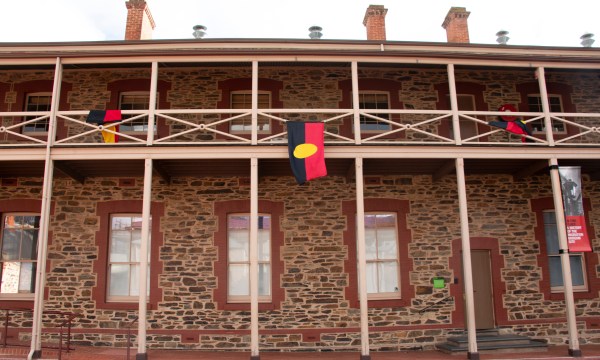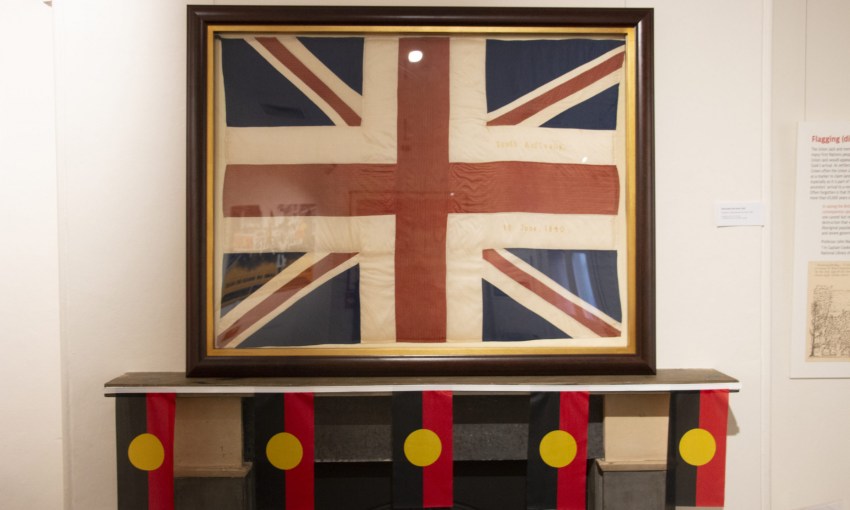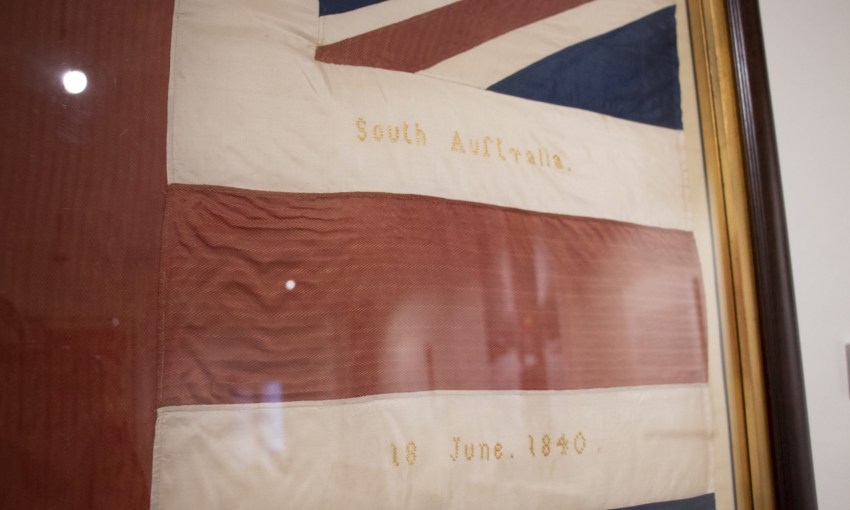Fifty years on since the SA-designed Aboriginal Flag was first flown at Tarntanyangga Victoria Square, two First Nations history curators have created an exhibition that explores its relationship to resistance, land rights and identity.
Explore the history of the Aboriginal Flag at the Migration Museum
Arrernte woman Jade Turner is one of the Migration Museum’s curators of First Nations history.
She shows up to our interview at the RE/CLAIMING COUNTRY exhibition wearing an ‘Always Was Always Will Be’ NAIDOC 2020 tee, and love-heart-shaped Aboriginal flag earrings pinned to her ears.
RE/CLAIMING COUNTRY
10 July–15 October 2021
10am ’til 5pm daily
Migration Museum
82 Kintore Ave, Adelaide 5000
More info here.
“The Aboriginal flag, to me, is representative of your place and showing your identity, especially for me because I’m light-skinned,” Jade tells CityMag.
“It’s that connection for me,” adds Adnyamathanha and Ngarrindjeri woman Jacinta Koolmatrie, another First Nations history curator responsible for organising the display.
“Whenever you see it [stuck somewhere], you know that someone or another Aboriginal person has been there.
“Or like if Jade’s wearing it, it usually means you’re Aboriginal. [And] there’s a little bit of solidarity with people, even if they’re not Aboriginal.”
The Migration Museum on North Terrace launched RE/CLAIMING COUNTRY last month, and it currently displays a diverse array of artefacts sourced from the History Trust’s collection.
There are British flags and other colonial material juxtaposed against pieces of modern, common ephemera, such as news articles and letters.
The aim is to give insight into the origin story of the Aboriginal flag and explore its contemporary context.
“It’s a small exhibition, but a significant one,” says Migration Museum Director Mandy Paul.
“It’s significant to Adelaide because it was designed and first flown here in July 1971, so we’re marking 50 years of that moment, but also because it’s become a really important symbol, particularly for First Nations people in Australia.”
The red, black and yellow Aboriginal Australian flag was originally designed by Luritja artist and activist Harold Thomas half a century ago in 1971, and first flown during a National Aborigines Day march through Tarntanyangga Victoria Square.
It then became the official flag of Canberra’s Aboriginal Tent Embassy, after it was flown there a year later in 1972.

“I did fight for the badge [in the exhibition]… and while it’s a small object, I like the idea of walking in and the first thing people see is that idea of land rights,” Jade says.
Jade says it’s important that this exhibition is held at the Migration Museum, because the flag was a pivotal tool in the modern Aboriginal land rights movement.
“People often forget it’s so affiliated with land rights, and that is actually why the flag exists,” she says.
“When you think of land rights, you think of the fact that Aboriginal people were here before other people came, and sovereignty was never actually ceded and still hasn’t ever been.”
The exhibition is displayed in non-chronological order, with stories mismatched and timelines sandwiched together.
This was a deliberate decision, made with First Nations audiences in mind.
“Aboriginal people see things all related – so people are related, events are interrelated,” Jade explains.
“When you think of Victoria Square, and all the things that have happened in Victoria Square, and then to think that’s the place [where the flag was once flown] and then you’ve got all these other events, I found that very interesting.”
Last June, Tarntanyangga Victoria Square was awash with a protest against police brutality and Indigenous deaths in custody, as Adelaide hosted its own version of the global Black Lives Matter demonstrations.

2020 BLM protest. This picture: Dimitra Koriozos

Rewind to 1904 and the same square bore witness to a very different event – the unveiling of a statue dedicated to colonialist explorer John McDouall Stuart.
A placard at the exhibition states: “Many Aboriginal people would say Stuart was never Welcome, nor traversed an undiscovered home-land, and where there might have been a peaceful crossing of paths, instead there was hostility.”
The exhibition also captures some of the hostility the Aboriginal flag received over the last 50 years, showing excerpts from news articles relating to local government figures burning the flag and describing it as a “revolutionary rag”.
The exhibition does not dive into the current furore of the Free the Flag movement.
Jade and Jacinta explain they weren’t able to do the necessary consultation with Harold Thomas in order to broach the subject meaningfully.
There is one letter, though, penned by Keanu Russo, an 11-year-old Aboriginal boy, addressed to Minister for Indigenous Affairs Ken Wyatt, in which Keanu asks that the “Aboriginal flag be freed from the limited copyright situation that currently exists”.
The letter continues, “I think it is absolutely appalling that, as an Aboriginal person, I have to pay money to use my people’s flag.”
Jacinta says the copyright issue is “such a heated topic”, but the legacy and meaning of the flag is about more than that.
To Jade, every instance of the flag seen in public – no matter how small – is a symbol of persistent defiance and solidarity.
Jade explains this notion in text, on a poster inside the exhibition, detailing a moment that inspired her to co-curate RE/CLAIMING COUNTRY.
“The idea for this exhibition originally came about in late 2020 when I was driving down King William Street on my way to work,” the poster says.
“I was sitting in my car, in the newly repopulated city streets, I glanced over to notice a lonely image of the Aboriginal Flag stuck to one of the tram poles.
“Immediately I felt that smile that often comes when you recognise an act of protest”.







